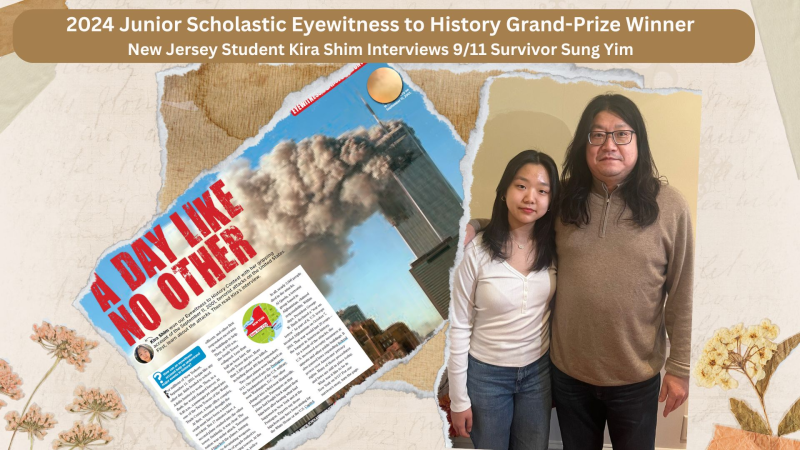A healthy body of water is one that is indicative of flourishing bug life. When you’ve got bugs in your creek or stream, you’ve got fish feeding on them. A healthy ecosystem in a stream or creek is one that has “macroinvertebrates”—animals without backbones, or in the case of middle school students in Gypsum, Colorado, the aquatic insects in their nearby Gore Creek. The health of Gore Creek (as well as other adjacent bodies of water) is suffering due to man-made technological disruption and overpopulation, and the population of macroinvertebrates in the water is reportedly well below normal levels. For their work aimed at researching (and restoring) the health of Gore Creek, the Gypsum, Colorado middle school students (Lisandro, Jazlyn, Paulethe, Kenneth, Brandon, Lily, Sieairra, Kalie, Kimi) are winners in the Lexus Eco Challenge, a national STEM-themed, teamwork-based contest for grades 6 to 12 created by Scholastic and Lexus.
Read on for a Q&A with the winning team’s teacher advisor!
Q: Discuss your project’s issue and the challenges your group faced along the way.
A: Gore Creek is a clear, rocky mountain stream. It is part of the Eagle County Watershed, and it runs through the town of Vail. For residents and visitors, Gore Creek offers recreation and a peaceful respite, as well as an important wildlife habitat. It’s also a water supply for downstream communities. In diverse locations throughout Vail, the river’s health is threatened by nonpoint source pollution, which deposits man-made and natural pollutants into bodies of water after rain or snowfall. A few of the nonpoint source pollutants include urban runoff, drainage from pavement and rooftops, and the loss of streamside vegetation that filters pollutants and slows their drainage into creeks and streams.
Some of the challenges that the group faced while implementing its Lexus Eco Challenge action plan were funding, transportation, site location for the most effective riparian buffers (vegetated areas to increase the health of a river), and more. We are a public school located 45 minutes from East Vail, which is where the sites were located for our action plan. We needed certain resources, such as macroinvertebrate nets, waders, shovels, native riparian plants, low-cost water- quality monitoring kits, and much more. Much of the funding for the action plan was worked out through a campaign at DonorsChoose.org and by creating partnerships. Through donors and our STEM classroom budget—along with the partnerships with The Town of Vail and Walking Mountains Science Center—the funding, transportation, and all of the resources were taken care of to make our dream a reality.
The money from the donors was used for our transportation on two different days to get from Gypsum to East Vail and back. We purchased the low-cost water- monitoring kits with our STEM classroom budget, while Walking Mountains Science Center supplied a helpful crew to assist with chaperoning and provided useful knowledge. The Town of Vail offered their expertise on riparian buffer site locations, their town landscape crew, plants, and other supplies such as shovels. It was a collective team effort: The STEM class at Gypsum Creek Middle School, Walking Mountains Science Center, and the Town of Vail made this action plan come together and be successful.
Q: Why did your team think it was an important subject?
A: The team felt this was an important subject because in STEM, we discuss “global issues.” We then address these global issues within the context of our community. Water quality is an issue here in Eagle County, and we want to make a difference in educating our community!
Q: We know you might be working on your Air & Climate entry (or thinking about the Final Challenge), but maybe you could tell us about your ongoing efforts with regard to pollution at your local creek?
A: There isn’t a lot of hands-on stuff for kids to do this time of year. We know that we want to add Gypsum Creek to our focus for next year’s action plan. When we compared the water quality in Gypsum Creek to Gore Creek’s, we found that Gypsum Creek has similar issues. We also know that we are continuing our efforts in Vail next school year if we can get the funding for transportation. I am keeping in touch with the partners for Gore Creek, and we hope to work on forming new partnerships when attempting to bring Gypsum Creek into this action plan.
I’m focused on grant writing, thank-you notes, professional training, and outreach events right now. We will plan another field trip or service project next spring or fall involving our watershed. The question remains: “How can educators use STEM to bridge the divide between coursework and the real world?”
Read more about the 2016–2017 winning teams and their inspiring projects here.
Photo: Walking Mountains Science Center





